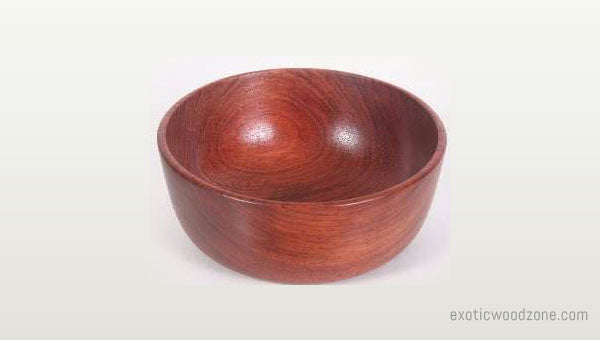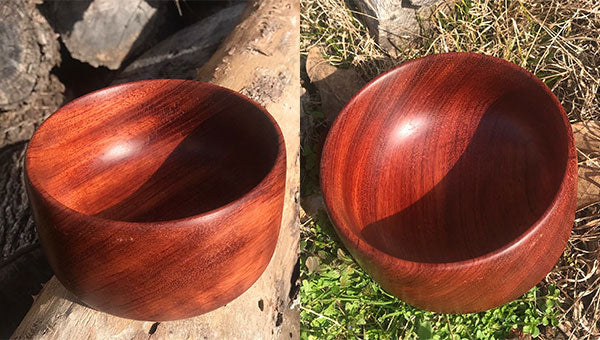Bubinga

| Common Name | This wood is also known by the common names as Rhodesian teak, African rosewood, amazique, Bubinga, kevazingo, and ovangkol. |
|---|---|
| Scientific Name | Guibourtia spp. (G. demeusei, G. pellegriniana, G. tessmannii) |
| Distribution | This tree is native to Equatorial Africa. They also occur in swampy or periodically inundated forests, as well as near rivers or at lakeshores. Equatorial Africa specifically western Africa including Gabon, Congo, and Angola. |
| Tree Size | This tree can grow up to a height of 130-150 ft (40-45 m) tall, with a trunk diameter of 3-6 ft (1-2 m) often with a heavily buttressed trunk. |
| Dried Weight ( average ) | 56 lbs/ft3 (890 kg/m3). |
| Specific Gravity | .72, .89 |
| Janka Hardness | 2,410 lbf (10,720 N) |
This wood is especially found in marshy or periodically inundated forests, in addition, close to rivers or at lakeshores. Bubinga is commonly referred to as “African Rosewood” attributable to its resemblance to Honduras rosewood. However, in contrast to Honduras rosewood, that tends to be slender and short, it has wide widths (often averaging 10” or better), and long lengths (up to 20’, typically averaging 12’ or better). It sells for 60% of the value of Honduran Rosewood. Bubinga heartwood may be pink, vivid red, or red-brown with purple streaks or veins, on exposure becomes yellow or medium brown with a chromatic tint, veining becomes less conspicuous. The sapwood is whitish and clearly demarcated from the duramen.
An immensely popular imported African hardwood, Bubinga is also idolized as much for its offbeat name as it is for its strength and wonder. Additionally generally referred to as Kevazingo, typically regarding its ornamental rotary-cut veneer.
Bubinga contains a close resemblance to rosewood and is commonly used in place of more expensive woods. Nevertheless, Bubinga additionally features a bunch of beautiful grain figures, like flamed, pommele, and falls, that create this wood actually distinctive. Bubinga additionally has an exceptional strength-to-weight magnitude relation.
Severe reactions are quite uncommon whereas operating with this wood. Though Bubinga has been rumored to cause skin irritation and/or skin lesions in some people. Hence protecting gear and properly equipped facilities ought to be provided.
The Bubinga is rated from moderately sturdy to very sturdy depending upon the species. Bubinga is additionally rumored to be resistant to the attack of termites and marine borers. The heartwood is rumored to be naturally immune to decay, moisture, and most insects.
Color and Appearance: The heartwood of this wood ranges from a pink-red to a darker achromatic with darker purple or black streaks. The sapwood could be a pale straw color and is clearly demarcated from the heartwood. Bubinga is incredibly often seen with a spread of figures, including pommele, flamed, waterfall, quilted, mottled, etc. Upon exposure to light and air, the wood becomes yellow or medium brown with a chromatic tint, and also the veining becomes less conspicuous.
Grain and Texture: The grain is straight to interlocked. While operating with interlocked grains care ought to be as tearout will occur. It has the same fine to medium texture and moderate natural luster. Diffuse-porous; medium pores in no specific arrangement; solitary and radial multiples of 2-3; mineral deposits sometimes present; growth rings distinct because of marginal parenchyma; rays faintly visible while not lens; parenchyma vasicentric, aliform, confluent, and banded (marginal).
Workability: On the whole, this wood is rated fairly simple to work with. Although it differs from species to species. Some species of Bubinga will have trace amounts of silica present in them, which might prematurely dull cutting tools and machines. Also, on pieces with patterned or interlocking grain, tearout will occur throughout planing or different machining operations. Gluing will sometimes be problematic because of Bubinga’s high density and natural oils. Reports are that this wood needs some gluing ability, as do all dense species, so as to attain a powerful glue joint, just as red oak needs. However, the gum pockets, if present, will interfere with sensible gluing. It turns and responds to stains and finishes well. Tung oil is usually recommended for finishing to bring out the deep tones of the wood. Bubinga ought to be wiped down with a lacquer agent to get rid of oils before waterproofing.
Machining this wood is really a bit easier than the high density would recommend. Nevertheless, it is a dense wood and needs sharp tools, correct MCs, and correct feed rates. The wood doesn't have minerals that might result in fast dulling, however, the high density will so lead to fast dulling. Rake angles could be got to be ablated slightly from oak values. Diamond tipped saws would appear price considering. thanks to the high density, the pre-boring of holes for nails and screws is important. Nail and screw holding power, even with pre-boring, is incredibly high. Upon exposure to light and air, the wood becomes yellow or medium brown with a reddish tint, and also the veining becomes less conspicuous. The surface seems somewhat lustrous. The wood is often polished simply.
Odor: Bubinga is reported to have an unpleasant scent once the lumber continues to be wet, which disappears when the wood is dry.
Availability: The Bubinga is moderately priced for an imported tropical hardwood. Figured grain patterns like falls, pommele, etc. are seem to be far more high-priced. Though Bubinga isn't evaluated on the IUCN Red List of vulnerable Species, the 3 Guibourtia species yielding Bubinga is listed on CITES appendix II—which additionally includes the export of either the raw kind of this wood or the finished products made from this wood.
Common Uses: This wood is usually used in veneer, inlays, fine pieces of furniture, cabinetry, turnings, and different specialty things. Since Bubinga trees will grow so large, natural-edge slabs of the wood that may be used in tabletops and different specialized projects. This genus is used as tropical hardwood timber and is listed beneath the common names like Bubinga, African rosewood, amazoue, amazique, kevazingo, and ovangkol.
The timber is additionally used for inlays and within the manufacture of high-end pieces of furniture (especially by modern Arts and Crafts artists), on high-end woodwork tools like the front knobs and rear handles of sleek planes, knife handles and medium-end tobacco pipes.
The timber is also commonly used by luthiers for harps and different instruments, like bass guitars, thanks to its mellow and all-round sound, and also the varied grain patterns. Warwick Bass and Ibanez are well-known to use Bubinga and Ovangkol. It has been employed in drum shells yet. Drum corporations like Tama supply varied high-end drum kits with plies of Bubinga within the shells. Craftsmen additionally use Bubinga on a number of their instruments. Bubinga is additionally employed in each acoustic and electric guitars for its figure and hardness.
Species of Guibourtia additionally produce congo copal.




Reference
